
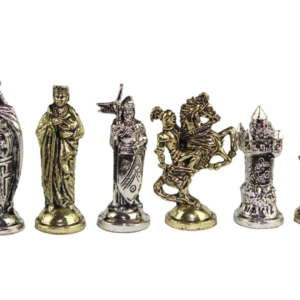
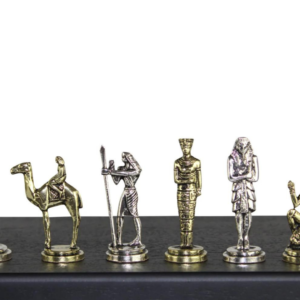

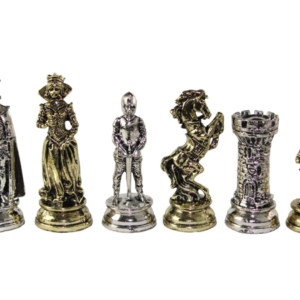
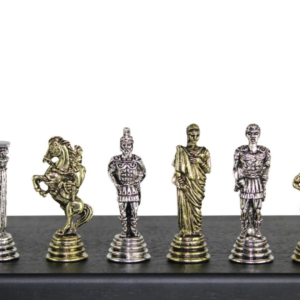

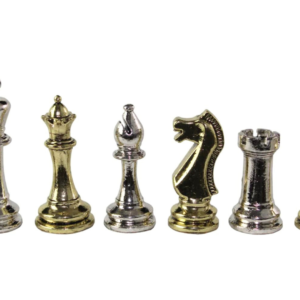
Chess has long been celebrated as a game of strategy, intellect, and discipline—an enduring pastime that transcends cultural and geographic boundaries. The beauty of the game isn’t just found in its complexity but also in the artistry of its pieces. While wood has historically dominated the design of chess sets, metal chess pieces have carved out a prestigious niche of their own, symbolising luxury, strength, and enduring elegance.
Metal chess pieces offer a tactile satisfaction and visual sophistication that few other materials can match. Their solid weight, polished finish, and sleek appearance make them popular among both serious players and collectors. Whether displayed as a decorative centrepiece or used in competitive play, metal chess sets convey a sense of timeless refinement. This article delves into the rich history, craftsmanship, materials, design variations, and enduring appeal of metal chess pieces.
The use of metal in chess sets dates back centuries, with early examples found across ancient civilisations. In regions such as Persia and India—where chess, known as chaturanga, first emerged—artisans often used metals like bronze or silver for ceremonial and luxury sets. These early examples were not merely gaming tools but objects of art, used by the elite and royalty as status symbols.
As chess spread to Europe during the Middle Ages, metal became an increasingly popular material for high-end chess pieces. Noble households often commissioned sets made from precious metals such as silver or gold, showcasing their wealth and status. These pieces were elaborately decorated, often reflecting the cultural and artistic trends of their time.
In the Renaissance and Baroque periods, metal chess pieces took on increasingly elaborate forms, with intricate designs inspired by mythology, religion, and historical figures. The Industrial Revolution brought new techniques in metalworking, making it easier to mass-produce chess sets from materials like brass, pewter, and iron. This shift allowed metal chess pieces to become more accessible to a broader audience while maintaining their luxurious appeal.
Today, metal chess sets continue to be associated with elegance and sophistication. They remain popular among serious chess enthusiasts, collectors, and those who appreciate the craftsmanship and artistry involved in creating these timeless pieces.
Creating a set of metal chess pieces requires both artistic skill and technical precision. The process begins with a design concept, often influenced by historical themes, modern aesthetics, or abstract artistic ideas. Once the design is finalised, the crafting process begins, combining traditional metalworking techniques with modern manufacturing methods.
One of the most common techniques used in crafting metal chess pieces is casting. This involves pouring molten metal into moulds shaped like the individual chess pieces. Once the metal cools and solidifies, the pieces are removed from the mould and carefully inspected for imperfections. Any excess material left from the casting process is trimmed away.
After casting, artisans often engage in engraving or etching to add fine details and textures. This step requires precision, as even the smallest mistake can alter the appearance of the final product. The engravings may include intricate patterns, symbolic motifs, or even personalised inscriptions.
The final stages of the process involve polishing and finishing. Polishing gives the pieces their characteristic shine, highlighting the natural beauty of the metal. Some chess sets are also plated with precious metals like gold or silver to enhance their visual appeal and increase their value.
This meticulous process reflects a deep respect for craftsmanship and tradition. Each piece is not just a functional object but a small work of art, combining aesthetic beauty with practical usability.
Metal chess pieces can be crafted from a wide range of materials, each offering unique visual and tactile qualities. The choice of metal not only affects the set’s appearance but also influences factors like weight, durability, and overall feel.
Brass is one of the most commonly used metals for chess pieces. It offers a warm, golden hue that adds a classic elegance to any set. Brass pieces are known for their durability and resistance to corrosion, making them ideal for both decorative use and regular gameplay.
Pewter is another popular choice, especially for decorative sets. Its soft, silver-grey appearance allows for fine detailing, making it ideal for ornate and intricately designed chess pieces. Pewter is also relatively heavy, providing a satisfying weight when handled.
Aluminium is a lightweight alternative that offers a sleek, modern look. Although not as heavy as other metals, aluminium chess pieces are highly durable and resistant to corrosion, making them suitable for practical everyday use.
Stainless Steel is prized for its modern aesthetic and exceptional durability. With a polished, reflective surface, stainless steel chess pieces convey a contemporary, industrial charm. They are highly resistant to wear and tarnish, making them an excellent choice for those who want a set that will last for decades.
For those seeking luxury, silver and gold-plated chess pieces offer unmatched elegance and prestige. These sets are often created as collector’s items or prestigious gifts, designed more for display than regular gameplay.
Each type of metal brings its own character to a chess set, allowing enthusiasts to select a style that best suits their taste and purpose.
The versatility of metal allows for a diverse range of design styles, from classical elegance to bold, modern aesthetics. Unlike wood or plastic, metal can be shaped and detailed with incredible precision, allowing artisans to create intricate, one-of-a-kind chess sets.
Traditional designs often draw inspiration from historical themes. For instance, medieval-themed sets might feature knights in full armour, kings and queens adorned with crowns, and rooks designed as castle towers. Such sets celebrate historical craftsmanship and storytelling, often resembling the elaborate designs of ancient and Renaissance chess pieces.
In contrast, modern metal chess sets often embrace minimalist or abstract designs. Sleek lines, geometric shapes, and polished surfaces define these contemporary sets, appealing to those who appreciate modern art and design. These sets often prioritise form and simplicity over ornate decoration, offering a sophisticated aesthetic for modern living spaces.
Some metal chess sets are crafted with thematic designs, drawing from mythology, literature, or even science fiction. These thematic sets are popular among collectors and enthusiasts who seek unique and visually striking pieces.
Custom-designed metal chess sets offer another avenue for artistic expression. Skilled artisans can create bespoke sets tailored to the buyer’s preferences, incorporating personalised engravings, unique themes, or specific materials. These custom pieces elevate metal chess sets from mere gaming tools to treasured works of art.
One of the most appealing aspects of metal chess pieces is their weight. Unlike lighter materials such as plastic or wood, metal provides a solid, substantial feel that enhances the tactile experience of playing chess. This added weight can significantly affect gameplay, offering better stability and balance during matches.
The weight of each piece contributes to a sense of deliberate action and strategy. Moving a metal piece feels more purposeful, adding to the psychological intensity of the game. Many serious players appreciate this sensation, as it complements the focused, thoughtful nature of chess.
Weight distribution is also crucial for gameplay. Well-balanced pieces offer improved stability on the board, reducing the risk of accidental tipping during play. This is particularly important in competitive settings, where focus and precision are essential.
Compared to lighter materials, metal chess pieces offer a unique playing experience that combines visual sophistication with physical satisfaction. For enthusiasts and serious players, the added weight and balance elevate the game, making every move feel meaningful and deliberate.
While metal chess pieces are highly durable, they do require proper care to maintain their appearance and functionality over time. Regular maintenance helps prevent tarnish, corrosion, and surface damage, ensuring that your chess set remains a timeless display of elegance.
For most metal pieces, regular cleaning with a soft cloth is sufficient to remove dust and fingerprints. For pieces made from materials like brass or pewter, using a gentle metal cleaner can help maintain their shine and prevent tarnish. It’s important to avoid abrasive cleaners or harsh chemicals, as these can scratch or damage the surface.
Polishing is essential for metals like silver or stainless steel to maintain their reflective brilliance. Specialised polishing cloths or solutions designed for specific metals can be used to achieve a high-gloss finish.
Proper storage also plays a key role in preserving metal chess pieces. Storing them in a lined chess box or protective case can prevent scratches and reduce exposure to moisture, which can lead to tarnishing over time. For antique or vintage sets, professional restoration services can help restore damaged pieces while preserving their historical value.
By following simple maintenance routines, owners can ensure that their metal chess pieces remain stunning and functional for generations.
Metal chess pieces continue to hold cultural significance beyond the game itself. Their aesthetic appeal and luxurious finish make them popular in high-end interior design, often displayed as decorative centrepieces in elegant living spaces, libraries, or executive offices.
In popular culture, metal chess sets have appeared in numerous films, television shows, and artworks, often symbolising power, intelligence, and sophistication. Their presence in visual media underscores their status as luxury items associated with strategic thinking and refined taste.
High-profile chess tournaments occasionally feature metal chess sets, adding an element of prestige to the competition. Their solid weight and aesthetic appeal make them a favourite among professional players and organisers seeking to elevate the visual impact of the event.
Additionally, with the rise of online chess platforms and digital adaptations, virtual representations of metal chess sets have gained popularity, allowing players to experience the visual elegance of metal pieces in a digital format.
Metal chess pieces embody the perfect fusion of art, craftsmanship, and strategic elegance. From their rich historical roots to their modern appeal, these pieces have captivated enthusiasts with their enduring beauty and functionality. Their weight, durability, and sophisticated aesthetic make them ideal for both serious gameplay and decorative display.
Whether you’re a seasoned chess player, a collector, or simply someone who appreciates fine craftsmanship, a set of metal chess pieces offers a timeless investment. They serve not only as tools for intellectual competition but also as works of art that reflect history, culture, and human creativity. In every move, metal chess pieces bring a sense of gravitas and refinement—an enduring testament to the elegance of the game itself.